Introduction
All buildings generally require some sort of fire and life safety precautions. Smaller residential buildings will require at the very least, fire detectors such as smoke and carbon detectors to alert occupants. While larger high rise buildings may require complex fire suppression systems and building wide alarm notification systems. On high rises in urban areas, these alarms may be directly connected to the local fire station providing almost immediate alert to the firefighters. The fire detection, alert, and suppression systems are all important parts of the building’s overall life safety and fire protection strategies.
Building codes and other regulatory guides are in existence to maintain and constantly improve the safety and welfare of human life. They are intended to be used by architects as a minimum standard only, and do not necessarily provide the best solution in every case. It is the architect’s ultimate responsibility to ensure the project meets the expectations expressed by regulatory agencies and codes, and therefore that they are designing a ‘safe’ building.
The purpose of licensing Architects is to assure that Architects are competent to protect the public’s health, safety, and welfare. An Architect must be able to design buildings that are structurally safe and meet the requirements for fire and health safety.
Primary Goals of Fire Resistance:
In order of importance:
- Protect human life
Permit the safe egress of occupants in case of fire. Architecture should delay the fire from spreading fast.
- Protection of property
Maintain structural integrity of a building and limit spread of a fire long enough to be fought by fire-fighters.
- Restoration and continued usefulness of a property after a fire.
Provide sufficient protection to the structure to limit damage and avoid collapse
Fire Protection Design Strategy Outline:
- Preventing Fires: Using non-combustible building materials and finishes and avoiding hazardous situations
- Early Fire Detection and Alarm: Sufficient warning must be given so that occupants can leave the building safely before help has arrived
- Planning for a Quick Exit: Allowing residents to leave quickly regardless of where they are located in the building. The exit should be easy to find and navigate, even in poorly lit conditions.
- Containing The Fire: Limiting the fire spread by choice of building materials, compartmentation, and smoke control.
- Suppressing the Fire: Automatic systems that help fight the fire.
Basic Fire Design Principles
- A fire in one building should not damage another building.
- A building’s construction should be able to withstand the effects of fire for a specified period of time.
- The more hazardous use, the more protection the building’s construction must provide.
- As the size of a building or occupants increase; so do the fire protection requirements.
- The higher the building, the more costly the building and the more strict codes and regulations.
- Occupants should be provided with a direct and safe means of escape from a building in the event of fire.
Miscellaneous Definitions and Notes
Flame And Smoke Ratings: Flame-spread and smoke ratings are measures of the amount of flame and smoke generated by specific materials.
- Ratings are established under standardized tests
- Plastics and other similar materials often generate highly toxic smoke
- Most people are harmed from smoke in a fire well before any harm from the flames.
Stairways: Interior enclosed stairways must be protected by fire-resistant construction. Stairways that serve as required building exits must meet numerous detailed requirements described by the code.
Smokeproof Enclosure (Fire Tower): In structures that are X feet or higher, at least one of the required exits must be a smokeproof tower.
Fire Wall: A firewall is a fire-resistant barrier (constructed as a wall) that prevents the spread of fire and smoke. Typically these are more significant walls which are required to resist seismic loads, have special requirements, will extend from exterior wall to exterior wall, and sometimes through the roof with a parapet of x amount.
Panic: Possibility of a panic in an emergency requires careful consideration, although it is not specifically detailed in the building code. A major factor in panic is the inability of people to see escape routes clearly.
- Some of the more obscure (or confusing) code rules can be boiled down to saying, ‘it helps prevent a panic’.
- Exit signs are particularly important and must be illuminated when a building is occupied and during emergencies. There are requirements for aesthetics of the exit sign.
- Panic Hardware: In certain places of assembly, the doors must be equipped with hardware that will automatically activate upon pressure.
Annunciator: In some situations, building code may require public announcements
Compartmentation
The strategy of compartmentation refers to limiting the fire spread and isolating certain spaces in a building. As stated, this helps prevent fire spread from one area of a building to another, but also provides the ability for occupants from one area to safely evacuate and be protected in their area.
- Compartmentation helps prevent mass exodus in situations where it may not be feasible for everyone to exit all at once. For example in a residential high rise, compartmentation is used to keep fires in each unit, and ideally isolated to one floor. This typically would allow other residents to stay in a safe space until help has arrived.
Building code achieves this by requiring different Occupancy Types to be separated by fire walls as well as other limitations such as max occupancy for a single space.
Larger Context
In urban environments, the compartmentation applies to the entire building as well so that the fire will not hop from one building to another. This requires the buildings to have limited openings along property lines and in cases when the opening does exist, more fire resistant materials. Buildings will also be setback from the other building as well.
Smaller Context
For individual buildings, the compartmentation happens not only from space to space but theoretically also system to system. This means structural members need to be protected so that the building will not collapse on itself in the event of a fire, regardless of what happens to the spaces themselves.
- Certain hard to access spaces are limited in size because a fire in those locations would be very hard to detect.
Smoke Control
As stated earlier, more deaths happen from smoke, and not the fire itself. Therefore smoke control and the ability to egress without smoke is utmost imperative to allowing safe evacuations. Smoke in particular is a problem because a fire will create warm air which rises due temperature differences which promotes convection across all connected building spaces. This means that the smoke will spread rapidly, even in the absence of air movement.
- Stack Effect: In high rise buildings that are essentially built with many inter-floor connecting shafts and spaces, the stack effect can cause the fire to rapidly spread. This is especially true if the facade design does not limit the spread, as evidenced by the Grenfell Tower Fire Tragedy.
Curtain Board (Draft Curtain) (Draft Stop): Vertical panel made from fire-resistive materials that is attached to the ceiling immediately adjacent to an opening. This is tightly secured to the ceiling so that no smoke can pass above it.
- Hangs a minimum of 18” off the ceiling – but depth varies per project requirements
- Typically near a double height opening in the floor like escalators, stairs, etc. To keep smoke on one level and not the other.
Compartmentation
As stated, one way to prevent smoke travel is through the compartmentation strategy discussed earlier. This helps secure an area and prevent smoke traveling outside of it. This is done with walls, smoke dampers, automatically shutting doors, and similar strategies.
Toxic Smoke
Another concern is the smoke created from burning of the materials in a building. Many times the building smoke will contain toxic gasses, causing long term health effects for users that are able to survive. Therefore, smoke ventilation is a major concern to not let the smoke exist/remain in spaces, and to try and dispel it out as much as possible. This helps with evacuation as well as the ability to fight the fire.
Design
Recent trends in the design world seem to continue progressing towards using less and less toxic materials. This ultimately will help in producing less toxic fumes if a fire occurs.
Passive Smoke Control System
A series of smoke barriers (partitions/barriers/curtain boards) are arranged to limit the migration of smoke. These systems do not rely on electrical or mechanical intervention to remove or redirect smoke.
Active Smoke Control System
Engineered system that uses mechanical fans to produce pressure differentials across different smoke compartments/barriers in order to establish beneficial and intended airflows to limit and direct smoke movement. Common use is in egress stairwells that require pressurization to keep smoke out of the stairwell in the event of a fire, allowing all users to safely walk down.
Standpipes
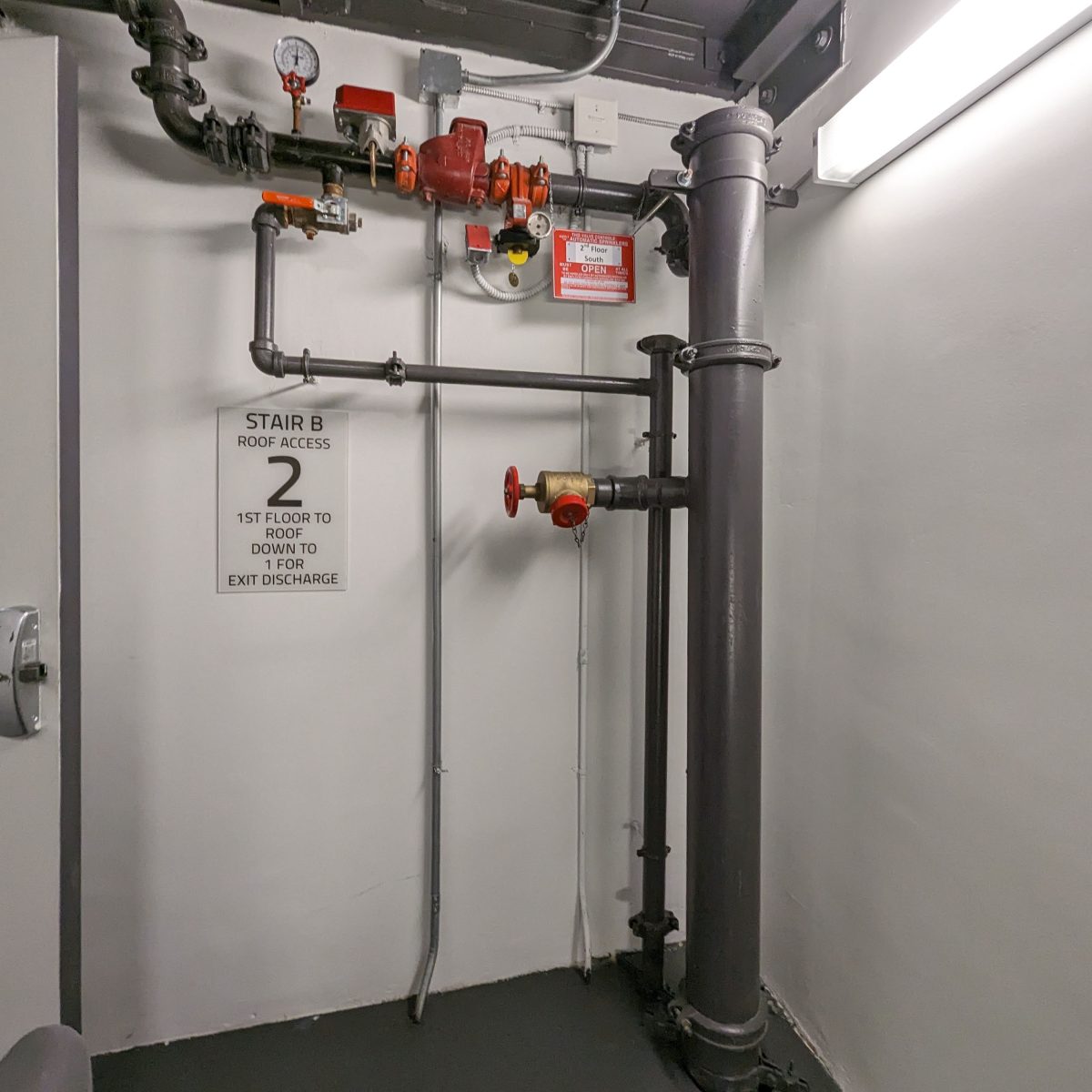


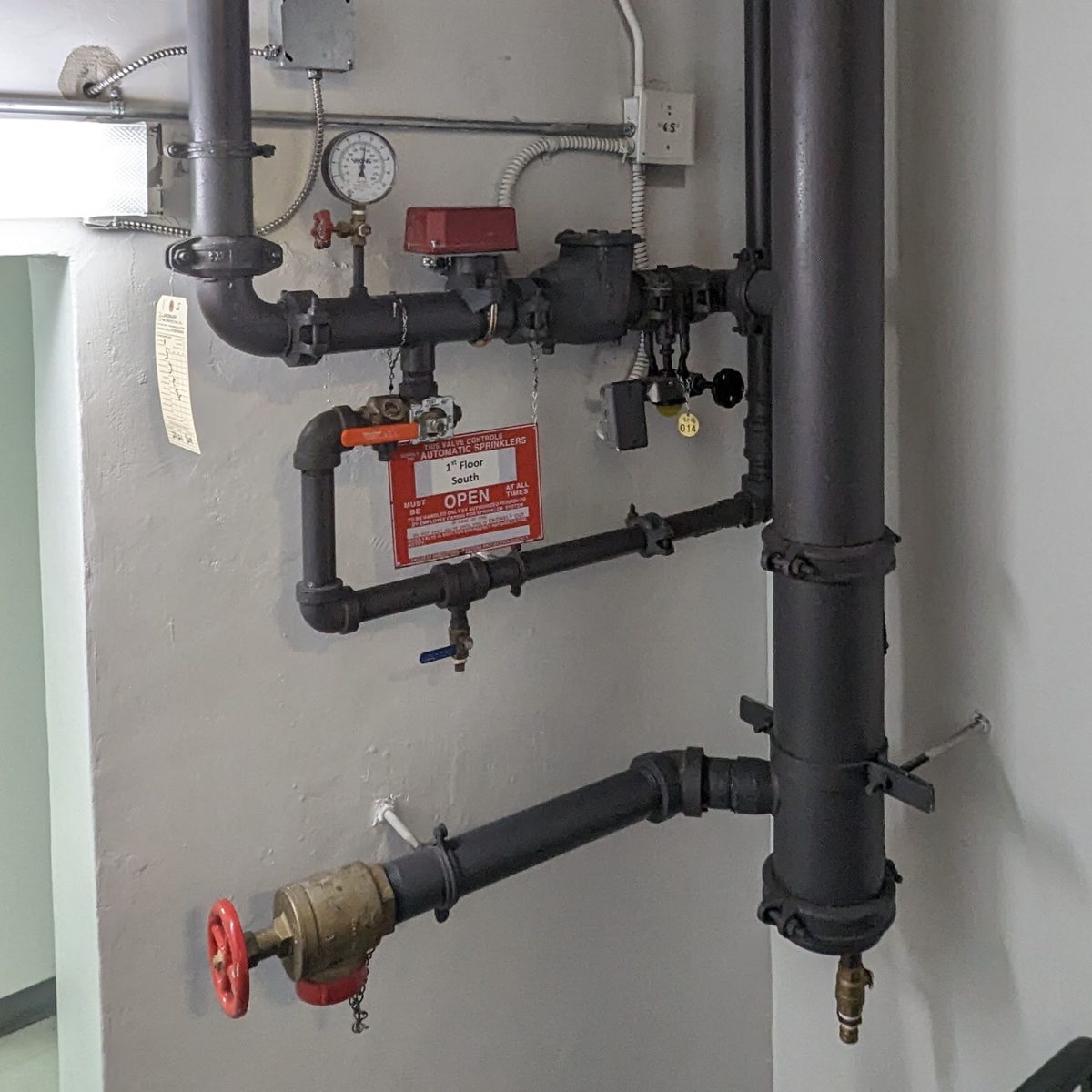

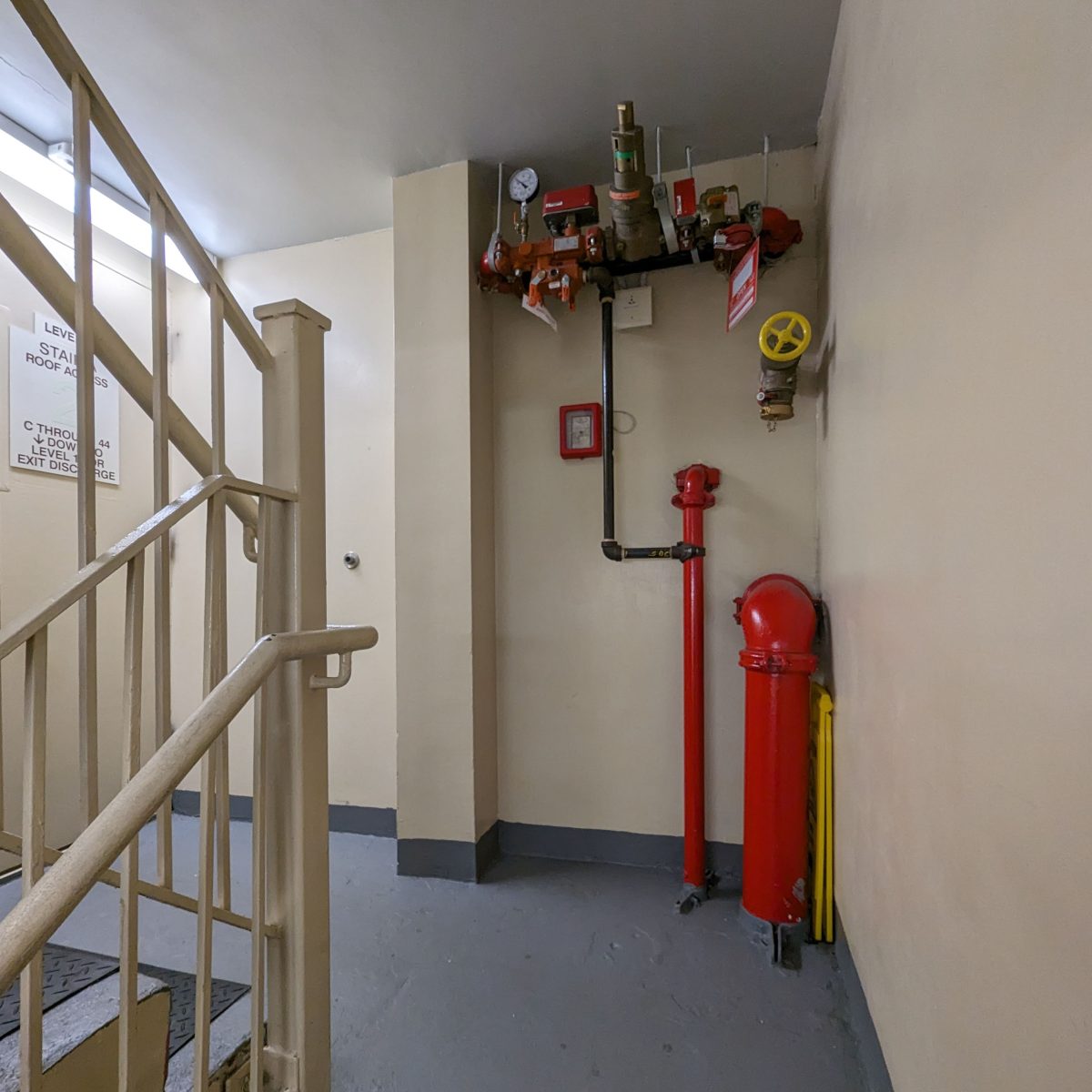
Standpipes are required in urban buildings of a certain number of stories or a minimum height or taller.
Standpipes are vertical pipes which carry water vertically through a building, and essentially act as a fire hydrant on every single floor. They are typically located in stairwells and will have fire hose cabinets already hooked up to them in some locations throughout. Each landing/accessed location will additionally have hookups for fire hoses.

Definitions
Standpipe: Vertical pipe that fire hoses can be connected to, they run the height of the building and provide outlets at every floor. Typically in stairways or pressurized vestibules.
Wet Standpipes: Continuously pressurized with water from a public source. A house tank (typically located on the roof) or other permanent water supply.
- Typically located in a smokeproof stairwell and will have hoses attached to it on the landing.
Dry Standpipes: Are not connected to a constant source of supply. Only a siamese fitting for the fire department and the fire department then supplies the water to the system either from a truck or through the truck (fire hydrant to truck to standpipe). As a dry fitting, they are not subject to freezing in cold weather so they are great for unheated buildings or spaces that may get colder like factories. Generally located in a smokeproof stair.
Combination Standpipe: Pressurized by a constant water supply and have a fire department siamese fitting. They serve both the occupants and the fire department but are primarily used by the fire department. Not all codes allow combination standpipes
Siamese Fitting: Allows the fire department to increase water pressure and flow in the wet standpipe.
Fusible Link: Small piece of wire that melts at a certain temperature and will act as a switch to open a vent, sprinkler head, or other fire-prevention system.
Egress
One big issue design wise with standpipes is that the standpipe goes from floor to ceiling, and has quite a lot of gauges and valves that can impede with the egress width needed in a stairwell. It’s imperative that the egress stairs which standpipes will be located in, are allocated enough room to provide adequate space for the standpipe.
During Construction
Standpipes must be carried upwards, floor by floor, as construction progresses and kept in working order for immediate use at any time.
IBC Ratings:
- CLASS I: dry-standpipe
- CLASS II: wet-standpipe
- CLASS III: Combination system directly connected to a water supply and equipped with both 1 ½” and 2 ½” outlets.
- Typically required anywhere the floor is 30’-0” above the highest level of fire department access.
Egress and Required Exits
Escalators, elevators, and fire escapes are not permitted to be counted as required exits.
- Revolving doors can be counted in some jurisdictions if they are able to collapse the doors due to air pressure.
High-Rise Building Special Precautions
Chapter 2 IBC defines a high-rise building as one “with an occupied floor located more than 75’-0” above the lowest level of fire department vehicle access.” Fire department ladders typically reach about 100’-0” maximum. With staging locations into consideration, this puts the max safe distance around 75’-0”. This means evacuation will take longer, and fire fighting above this level is more complicated and difficult. Therefore, special precautions must be taken.
- Buildings are typical office, hotels, and apartment buildings
The IBC requires several special systems and provisions for high-rise buildings.
- Sprinkler system
- Smoke detectors & alarms
- Communication systems
- Central control station for fire department use
- Smoke control for exit stair enclosures
- Standby power systems
Glazing: There are special considerations regulating the glazing systems and assemblies used in high-rise buildings.
Area of Refuge: Area where people unable to use stairways can remain temporarily while waiting for assistance.
- Each area should accommodate a wheelchair in a space of 30” x 48” for every 200 Occupants.
- Areas of refuge not generally required in buildings that are sprinklered, however, code needs to be checked.
Steps to Determine Code Compliance of a a Building:
Code is extremely complex and code expeditors exist for a reason. It’s extremely hard to determine full compliance and proper experts should always be consulted.
- Fire Protection Codes (IBC): Generally try to protect human life
- Life Safety Codes (NFPA): Generally address and protect egress.
Steps:
- Use Group – Determine the appropriate use and classification of a building
- Height and Area – Type of construction based on building use group and the height/area limitations of zoning/FAR.
- Type of Construction – Determine compliance with construction of building by the building materials and fire resistance rating of the building elements
- Siting – Determine the location of the building on the site, including separation from lot lines and other buildings.
- Fire Performance – Determine compliance with detailed requirements for fire resistance and protection systems
- Interior Environment Design – Determine compliance with special use of occupancy requirements – means of egress, accessibility, and interior environments requirements. Taking note of finish material specifications such as flame spread.
- Exterior Envelope – Determine compliance with exterior envelope requirements as well as energy requirements.
- Structural Performance – Determine compliance with structural requirements and building material requirements
- Building Service system – Determine compliance with the various building service systems.
NFPA 101 – “The Life Safety Code” – Goals and Checklist
National Fire Protection Agency (NFPA) is a registered trademark.
- Provide adequate exits without dependence on any one safeguard
- To ensure the construction is sufficient to provide structural integrity during a fire
- To provide exits that have been designed to the size, shape, and nature of the occupancy
- Ensure that the exits are clear, unobstructed and unlocked
- To ensure that the exits are clearly marked, so there is no confusion in reaching an exit
- Provide adequate lighting
- Ensure Early warning of fire
- Provide backup or redundant exit arrangements
- Ensure suitable enclosure of vertical openings
- Make allowances for those design criteria that go beyond code provisions and are tailored to the normal use and needs of the occupancy in question.


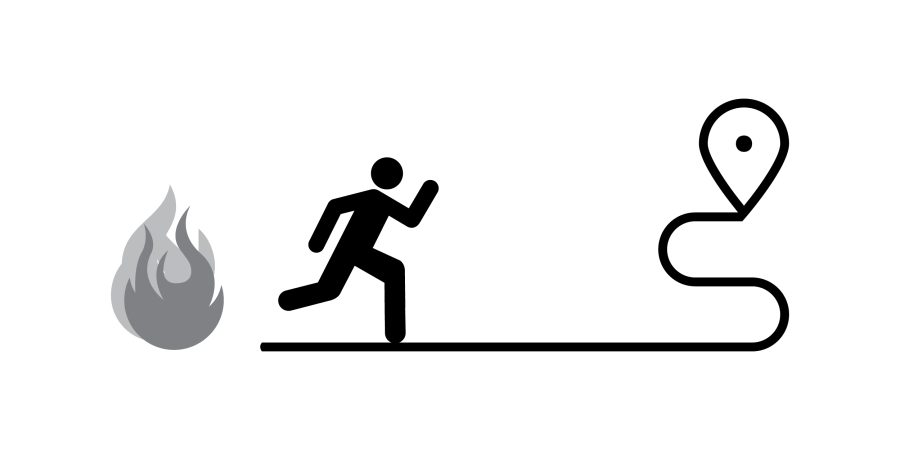

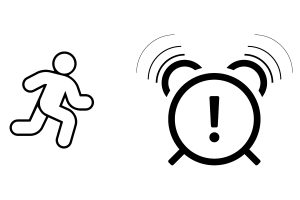

Leave a Reply
You must be logged in to post a comment.